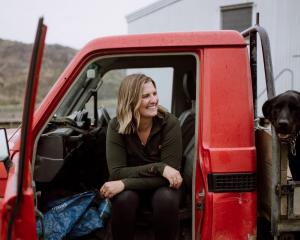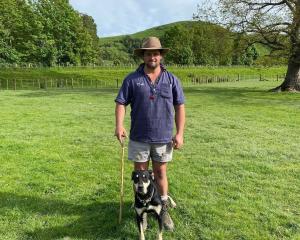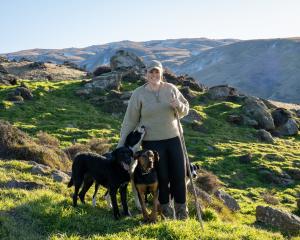
Western Southland sharemilkers Michael and Cherie Berkers will sell the best of their herd to realise their dream of owning a farm.
"All the top end is going. Anything good, we are going to sell," Mr Berkers said.
The sale would be held exclusively on digital auction platform Bidr over two days from tomorrow and would offer nearly 190 milking cows, nearly 40 rising 2-year-old heifers, about 30 rising 1-year-old heifers and six rising 1-year-old bulls.
The herd run in their business Moovin Aherd Ltd was a mix of crossbred, Holstein Friesian and Jersey.
Mr Berkers said he hoped the proceeds from the sales would be enough to allow the family to buy their first dairy farm.
Farm ownership had been his dream.
"It is important to me."
The rest of their herd might be sold by private treaty depending on the terms of the farm purchase.
"This is where the crunch is," Mr Berkers said.
If a potential farm sale includes cows of the same value as their own, he would retain their remaining herd and ask the farm vendor to sell their cows.

He and his wife were raised on dairy farms in Waikato and met as adults, while working in the dairy industry in the South.
Mr Berkers left high school early because he knew he wanted to be a dairy farmer.
He completed a Diploma in Agriculture part-time at Waikato Polytechnic, while working on dairy farms in the province.
His career progression in Waikato includes lower-order sharemilking 200 cows and employing staff by age 19.
By age 21, he was lower-order sharemilking 400 cows and employing more staff.
Dairy farm ownership was a dream and the only land available in Waikato was in "goat country", he said.
Southland had great, flat land available.
"It is good country."
Dairy farming in the South required a change in mindset due to the environment.
"Here you farm for the winter and up north you farm the summer."

"I’ll go wherever it suits the cows."
He sold his cows in the Waikato to work in lower-order jobs in Otago and Southland from the late 1990s.
"At that stage I met Cherie, who was managing farms and we were quite like-minded."
A difference between the two was he liked Holstein Friesian cattle and she loved Jersey cattle.
They got married about 18 years ago, six months after meeting, Mr Berkers said.
"It all happened pretty fast but when it works, it works."
The couple have four children, sons William, 18, and Harrison, 17, and daughters Jordan, 15, and Danica, 13.
"Bringing up kids here is awesome."
The family had been 50:50 sharemilking for Doug and Jan Fraser, milking 400 cows on a 138ha dairy platform in Gropers Bush for the past nine years.
Nine years was a long time for a sharemilker to stay on a farm, he said.

The search for a farm to buy was ongoing, he said.
An ideal farm would be within a 40-minute drive from Invercargill so their children could get to school, Mr Berkers said.
"All of our friends are here, our kids have grown up here — it is a really lovely community. Home is where you make it."
Ideally their new farm would have the potential to run between 400 and 700 cows.
A perfect property would be far from a river.
Both of them were raised on farms near rivers and they would prefer to reduce any potential for flooding.
Their current farm system relies on them doing most of the work on the farm, working around Mrs Berkers’ job as an artificial breeding technician for LIC.
In the first six weeks of the mating period, 68% of their cows were pregnant.
After mating, 7% of the cows were empty, or not-in-calf.
"We are real happy," Mr Berkers said.
A vet body condition scores the herd three times a year.

If a cow was light at dry off, she did not put enough weight on during winter to prepare for calving.
"You are then behind the eight ball from spring on."
The herd was milked twice a day, cups on from 5am and 2.30pm.
If a cow was light, she was only milked once a day to improve her body condition.
"That’s really important."
After the top of their herd sold, they were looking forward to the challenge of breeding more cows and creating a valuable asset.
"We are trying to create an appealing herd, which we can sell for the highest margin possible to move forward and then start again."
About 20 of their herd were holding embryos flushed from their cows to start the core of the next herd, he said.
Breeding objectives included producing a robust cow with a nice temperament, good udders and milk production, he said.
He did not use technology to run his herd, such as automatic cup removers in the Rotaflo milking shed, smart collars or GPS tracking software Protrack.
"I use Brotrack — it is just me, I’m always in the shed."

He was pleased his herd were not wearing any smart technology during the wet spring last year.
"It would have kept telling me I wasn’t feeding the cows enough and ignorance is bliss."
As he worked with the cows daily, he did not need technology to know the cows’ growth rates and body condition.
During the challenging time, the herd was getting an extra 11kg of supplementary feed per day.
Normally,when the grass was growing, the cows were given 2kg of supplement.
The supplementary feed was a mix of barley palm kernel and dried distillers grains provided in the milking shed.
A target was for each cow to produce more than 500kg of milksolids a season, which they were on track to do but it did require a lot of supplementary feed this season.
"We are even with last year’s production but we spent another $120,000 getting it — is that efficient? No but on a $10 payout, it worked so it was a gamble but it protects the cows, so what can you do?"
Farming conditions were great now, Mr Berkers said.
"We have sun, dry ground and the cows are leaving [pasture] residual — this is our farming happy place — it is pretty cool."















